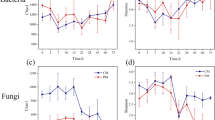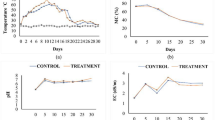Abstract
Distilled grain waste (DGW) can be converted to organic fertilizer via aerobic composting process without inoculating exogenous microorganisms. To illustrate the material conversion mechanism, this study investigated the dynamic changes of bacterial community structure and metabolic function involved in DGW composting. Results showed that a significant increase in microbial community alpha diversity was observed during DGW composting. Moreover, unique community structures occurred at each composting stage. The dominant phyla were Firmicutes, Proteobacteria, Actinobacteriota, Bacteroidota, Myxococcota, and Chloroflexi, whose abundance varied according to different composting stages. Keystone microbes can be selected as biomarkers for each stage, and Microbispora, Chryseolinea, Steroidobacter, Truepera, and Luteimonas indicating compost maturity. Co-occurrence network analysis revealed a significant relationship between keystone microbes and environmental factors. The carbohydrate and amino acid metabolism were confirmed as the primary metabolic pathways by metabolic function profiles. Furthermore, nitrogen metabolism pathway analysis indicated that denitrification and NH3 volatilization induced higher nitrogen loss during DGW composting. This study can provide new understanding of the microbiota for organic matter and nitrogen conversion in the composting process of DGW.






Similar content being viewed by others
Availability of Data and Materials
Not applicable.
Code Availability
Not applicable.
References
Zhou, X. B., & Zheng, P. (2013). Spirit-based distillers’ grain as a promising raw material for succinic acid production. Biotechnology Letters, 35(5), 679–684.
Tan, L., Sun, Z. Y., Zhang, W. X., Tang, Y. Q., Morimura, S., & Kida, K. (2014). Production of bio-fuel ethanol from distilled grain waste eluted from Chinese spirit making process. Bioprocess and Biosystems Engineering, 37(10), 2031–2038.
Zhang, J., Zhang, W. X., Wu, Z. Y., Yang, J., Liu, Y. H., Zhong, X., & Deng, Y. (2013). A comparison of different dilute solution explosions pretreatment for conversion of distillers’ grains into ethanol. Preparative Biochemistry & Biotechnology, 43(1), 1–21.
Yang, L., Zhang, S. H., Chen, Z. Q., Wen, Q. X., & Wang, Y. (2016). Maturity and security assessment of pilot-scale aerobic co-composting of penicillin fermentation dregs (PFDs) with sewage sludge. Bioresource Technology, 204(3), 185–191.
Wang, S. P., Wang, L., Sun, Z. Y., Wang, S. T., Shen, C. H., Tang, Y. Q., & Kida, K. (2021). Biochar addition reduces nitrogen loss and accelerates composting process by affecting the core microbial community during distilled grain waste composting. Bioresource Technology, 337, 125492.
Meng, Q. X., Yang, W., Men, M. Q., Bello, A., Xu, X. H., Xu, B. S., Deng, L. T., Jiang, X., Sheng, S. Y., Wu, X. T., Han, Y., & Zhu, H. F. (2019). Microbial community succession and response to environmental variables during cow manure and corn straw composting. Frontiers in Microbiology, 10, 529.
Song, X. C., Liu, M. Q., Wu, D., Qi, L., Ye, C. L., Jiao, J. G., & Hu, F. (2014). Heavy metal and nutrient changes during vermicomposting animal manure spiked with mushroom residues. Waste Management, 34(11), 1977–1983.
Huang, Y. L., Sun, Z. Y., Zhong, X. Z., Wang, T. T., Tan, L., Tang, Y. Q., & Kida, K. (2017). Aerobic composting of digested residue eluted from dry methane fermentation to develop a zero-emission process. Waste Management, 61, 206–212.
Wang, S. P., Zhong, X. Z., Wang, T. T., Sun, Z. Y., Tang, Y. Q., & Kida, K. (2017). Aerobic composting of distilled grain waste eluted from a Chinese spirit-making process: The effects of initial pH adjustment. Bioresource Technology, 245(Pt A), 778–785.
Sun, Z. Y., Zhang, J., Zhong, X. Z., Tan, L., Tang, Y. Q., & Kida, K. (2016). Production of nitrate-rich compost from the solid fraction of dairy manure by a lab-scale composting system. Waste Management, 51, 55–64.
Wang, X., Selvam, A., Chan, M., & Wong, J. W. C. (2013). Nitrogen conservation and acidity control during food wastes composting through struvite formation. Bioresource Technology, 147, 17–22.
Zhong, X. Z., Li, X. X., Zeng, Y., Wang, S. P., Sun, Z. Y., & Tang, Y. Q. (2020). Dynamic change of bacterial community during dairy manure composting process revealed by high-throughput sequencing and advanced bioinformatics tools. Bioresource Technology, 306, 123091.
Bello, A., Han, Y., Zhu, H., Deng, L., Yang, W., Meng, Q., Sun, Y., Egbeagu, U. U., Sheng, S., Wu, X., Jiang, X., & Xu, X. (2020). Microbial community composition, co-occurrence network pattern and nitrogen transformation genera response to biochar addition in cattle manure-maize straw composting. Science of the Total Environment, 721, 137759.
Qiu, X. W., Zhou, G. X., Zhang, J. B., & Wang, W. (2019). Microbial community responses to biochar addition when a green waste and manure mix are composted: A molecular ecological network analysis. Bioresource Technology, 273, 666–671.
Zhu, L., Zhao, Y., Zhang, W., Zhou, H., Chen, X., Li, Y., Wei, D., & Wei, Z. (2019). Roles of bacterial community in the transformation of organic nitrogen toward enhanced bioavailability during composting with different wastes. Bioresource Technology, 285, 121326.
Wei, H., Wang, L., Hassan, M., & Xie, B. (2018). Succession of the functional microbial communities and the metabolic functions in maize straw composting process. Bioresource Technology, 256, 333–341.
Cai, L., Chen, T. B., Gao, D., & Yu, J. (2016). Bacterial communities and their association with the bio-drying of sewage sludge. Water Research, 90, 44–51.
Sun, Y., Men, M., Xu, B., Meng, Q., Bello, A., Xu, X., & Huang, X. (2019). Assessing key microbial communities determining nitrogen transformation in composting of cow manure using illumina high-throughput sequencing. Waste Management, 92, 59–67.
Meng, X. Y., Liu, B., Zhang, H., Wu, J. W., Yuan, X. F., & Cui, Z. J. (2019). Co-composting of the biogas residues and spent mushroom substrate: Physicochemical properties and maturity assessment. Bioresource Technology, 276, 281–287.
Thelusmond, J. R., Strathmarin, T. J., & Cupples, A. M. (2016). The identification of carbamazepine biodegrading phylotypes and phylotypes sensitive to carbamazepine exposure in two soil microbial communities. Science of the Total Environment, 571, 1241–1252.
Zhang, X., Li, S., Cheng, W., Zhao, Y., Cui, H., Xie, X., Wu, J., Wei, Z., & Liu, Y. (2021). Oxytetracycline stress reconstruct the core microbial community related to nitrogen transformation during composting. Bioresource Technology, 319, 124142.
Zhu, P., Li, Y., Gao, Y., Yin, M., Wu, Y., Liu, L., Du, N., Liu, J., Yu, X., Wang, L., & Guo, W. (2021). Insight into the effect of nitrogen-rich substrates on the community structure and the co-occurrence network of thermophiles during lignocellulose-based composting. Bioresource Technology, 319, 124111.
Zhang, C., Gao, Z., Shi, W., Li, L., Tian, R., Huang, J., Lin, R., Wang, B., & Zhou, B. (2020). Material conversion, microbial community composition and metabolic functional succession during green soybean hull composting. Bioresource Technology, 316, 123823.
Jiao, S., Zhang, Z. Q., Yang, F., Lin, Y. B., Chen, W. M., & Wei, G. H. (2017). Temporal dynamics of microbial communities in microcosms in response to pollutants. Molecular Ecology, 26(3), 923–936.
Langille, M. G. I., Zaneveld, J., Caporaso, J. G., McDonald, D., Knights, D., Reyes, J. A., Clemente, J. C., Burkepile, D. E., Thurber, R. L. V., Knight, R., Beiko, R. G., & Huttenhower, C. (2013). Predictive functional profiling of microbial communities using 16S rRNA marker gene sequences. Nature Biotechnology, 31(9), 814–821.
Kanehisa, M., Sato, Y., Furumichi, M., Morishima, K., & Tanabe, M. (2019). New approach for understanding genome variations in KEGG. Nucleic Acids Research, 47(D1), D590–D595.
Zhou, G., Xu, X., Qiu, X., & Zhang, J. (2019). Biochar influences the succession of microbial communities and the metabolic functions during rice straw composting with pig manure. Bioresource Technology, 272, 10–18.
Liang, C., Das, K. C., & McClendon, R. W. (2003). The influence of temperature and moisture contents regimes on the aerobic microbial activity of a biosolids composting blend. Bioresource Technology, 86(2), 131–137.
Lu, Y. J., Wu, X. W., & Guo, J. F. (2009). Characteristics of municipal solid waste and sewage sludge co-composting. Waste Management, 29(3), 1152–1157.
Zeng, G. M., Zhang, L. H., Dong, H. R., Chen, Y. N., Zhang, J. C., Zhu, Y., Yuan, Y. J., Xie, Y. K., & Fang, W. (2018). Pathway and mechanism of nitrogen transformation during composting: Functional enzymes and genes under different concentrations of PVP-AgNPs. Bioresource Technology, 253, 112–120.
Zeng, Y., De Guardia, A., Ziebal, C., De Macedo, F. J., & Dabert, P. (2012). Nitrification and microbiological evolution during aerobic treatment of municipal solid wastes. Bioresource Technology, 110, 144–152.
Cáceres, R., Malińska, K., & Marfà, O. (2018). Nitrification within composting: A review. Waste Management, 72, 119–137.
Tiquia, S. M., & Tam, N. F. Y. (1998). Elimination of phytotoxicity during co-composting of spent pig-manure sawdust litter and pig sludge. Bioresource Technology, 65(1–2), 43–49.
Awasthi, M. K., Duan, Y. M., Liu, T., Awasthi, S. K., & Zhang, Z. Q. (2020). Relevance of biochar to influence the bacterial succession during pig manure composting. Bioresource Technology, 304, 122962.
Zhong, X. Z., Ma, S. C., Wang, S. P., Wang, T. T., Sun, Z. Y., Tang, Y. Q., Deng, Y., & Kida, K. J. (2018). A comparative study of composting the solid fraction of dairy manure with or without bulking material: Performance and microbial community dynamics. Bioresource Technology, 247, 443–452.
Yang, Y., Awasthia, Mukesh Kumar, Bao, H., Bie, J., Lei, S., & Lv, J. (2020). Exploring the microbial mechanisms of organic matter transformation during pig manure composting amended with bean dregs and biochar. Bioresource Technology, 313, 123647.
Zou, W., Zhao, C. Q., & Luo, H. B. (2018). Diversity and function of microbial community in Chinese Strong-Flavor Baijiu ecosystem: A review. Frontiers in Microbiology, 9, 671.
Zhang, L. L., Zhang, H. Q., Wang, Z. H., Chen, G. J., & Wang, L. S. (2016). Dynamic changes of the dominant functioning microbial community in the compost of a 90–m3 aerobic solid state fermentor revealed by integrated meta-omics. Bioresource Technology, 203, 1–10.
Zhang, W. M., Yu, C. X., Wang, X. J., & Hai, L. (2020). Increased abundance of nitrogen transforming bacteria by higher C/N ratio reduces the total losses of N and C in chicken manure and corn stover mix composting. Bioresource Technology, 297, 122410.
Kuypers, M. M. M., Marchant, H. K., & Kartal, B. (2018). The microbial nitrogen-cycling network. Nature Reviews Microbiology, 16(5), 263–276.
Wang, K., Wu, Y., Li, W., Wu, C., & Chen, Z. (2018). Insight into effects of mature compost recycling on N2O emission and denitrification genes in sludge composting. Bioresource Technology, 251, 320–326.
Said-Pullicino, D., & Gigliotti, G. (2007). Oxidative biodegradation of dissolved organic matter during composting. Chemosphere, 68(6), 1030–1040.
Funding
This research was funded by the Key Laboratory of Wuliangye-flavor Liquor Solid-state Fermentation, China National Light Industry (2021JJ002), the Solid-state Fermentation Resource Utilization Key Laboratory of Sichuan Province (2018GTY005), and the Graduate Student’s Research and Innovation Fund of Sichuan University (2012017yjsy165).
Author information
Authors and Affiliations
Contributions
Conceptualization: S.P. Wang, Z.Y. Sun; methodology and investigation: S.P. Wang; data curation: S.P. Wang, Z.Y. Sun, S.T. Wang; visualization: S.P. Wang, S.T. Wang, H.W. Yuan; writing—original draft: S.P. Wang; formal analysis: S.T. Wang, H.W. Yuan, M.Z. An; validation: S.T. Wang, Z.Y. Xia; funding acquisition: Z.Y. Sun, H.W. Yuan, M.Z. An; writing—review and editing: Z.Y. Sun, Z.Y. Xia, Y.Q. Tang, C.H. Shen, K. Kida; project administration: Y.Q. Tang, C.H. Shen, K. Kida.
Corresponding author
Ethics declarations
Ethical Approval
Not applicable.
Consent to Participate
I confirm that the final manuscript has been seen and approved by all the authors.
Consent to Publish
All the authors mutually agreed that the work should be published in Applied Biochemistry and Biotechnology.
Competing Interests
The authors declare no competing interests.
Additional information
Publisher's Note
Springer Nature remains neutral with regard to jurisdictional claims in published maps and institutional affiliations.
Highlights
1. Bacterial community dynamics is involved in distilled grain waste composting.
2. Unique community structures and keystone microbes are present at different stages.
3. Keystone microbes and environmental factors exhibited significant relationship.
4. Carbohydrate and amino acid metabolism were the primary metabolic pathways.
5. Denitrification and NH3 volatilization caused higher nitrogen loss.
Supplementary Information
Below is the link to the electronic supplementary material.
Rights and permissions
About this article
Cite this article
Wang, SP., Sun, ZY., Wang, ST. et al. Bacterial Community Structure and Metabolic Function Succession During the Composting of Distilled Grain Waste. Appl Biochem Biotechnol 194, 1479–1495 (2022). https://doi.org/10.1007/s12010-021-03731-5
Received:
Accepted:
Published:
Issue Date:
DOI: https://doi.org/10.1007/s12010-021-03731-5




